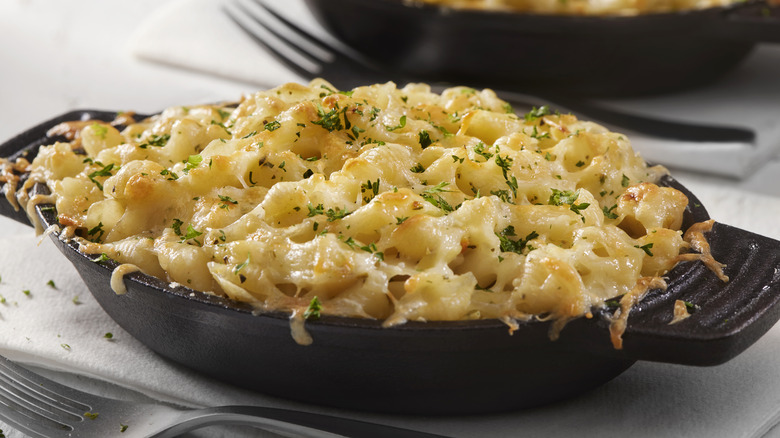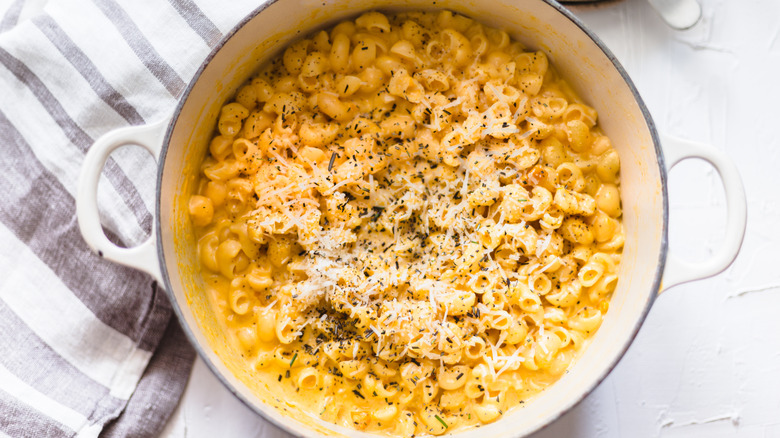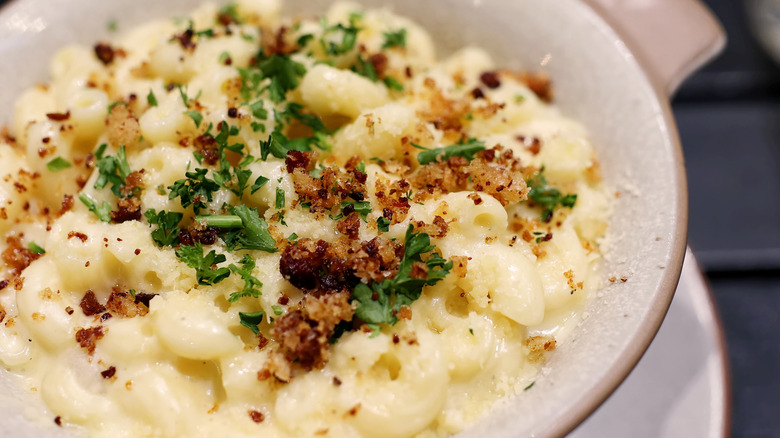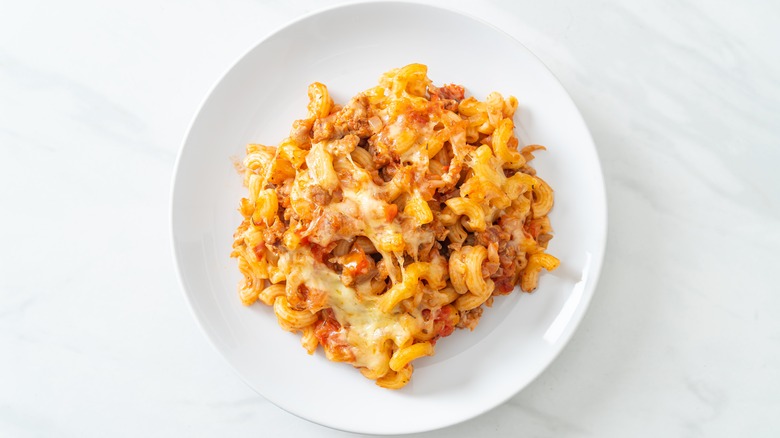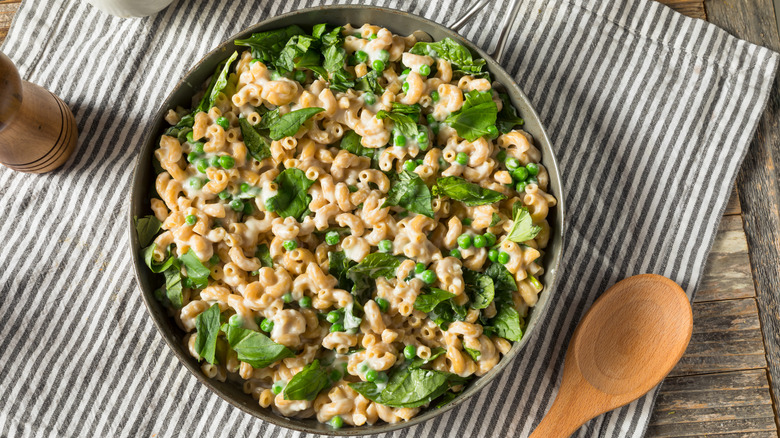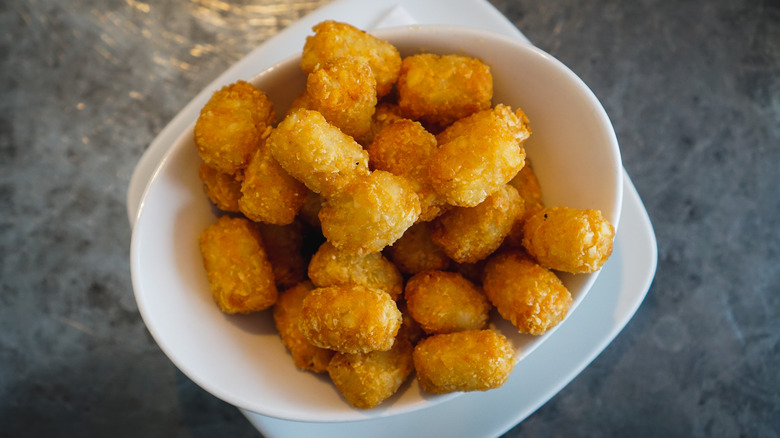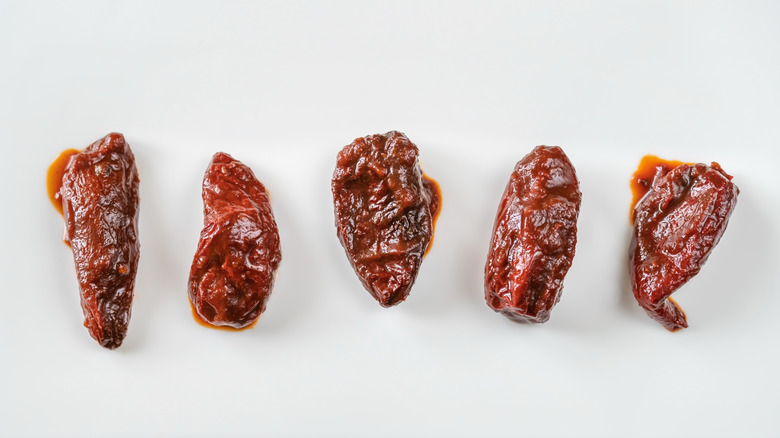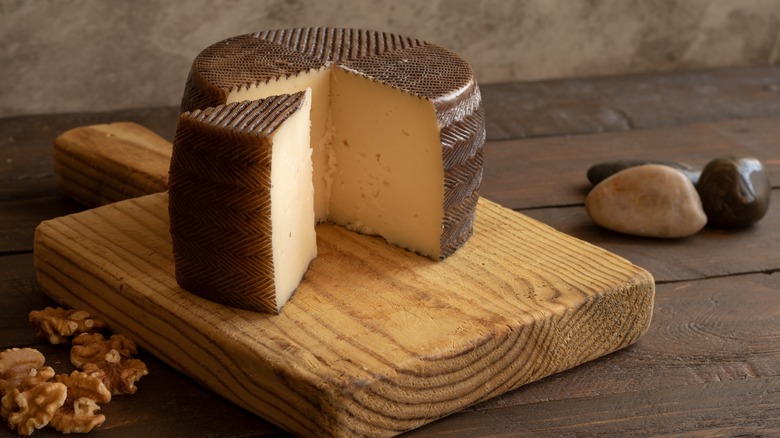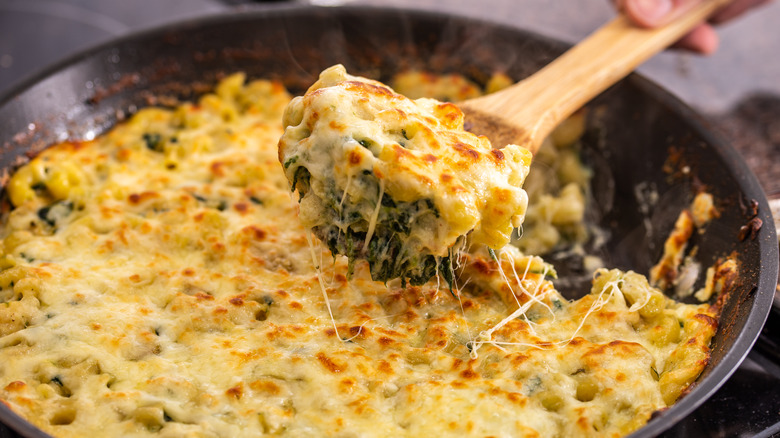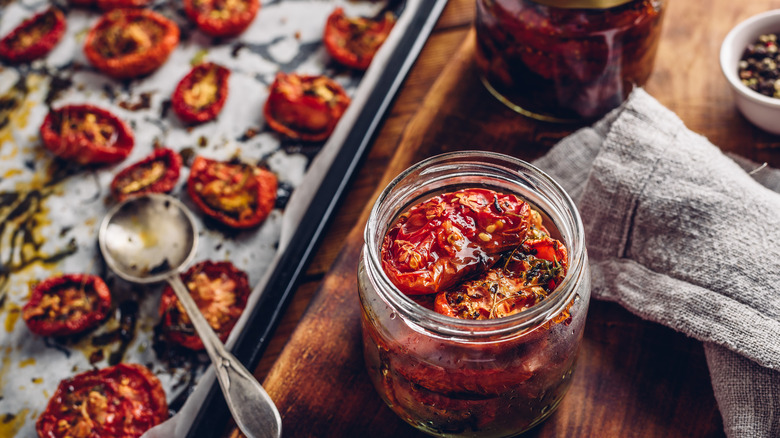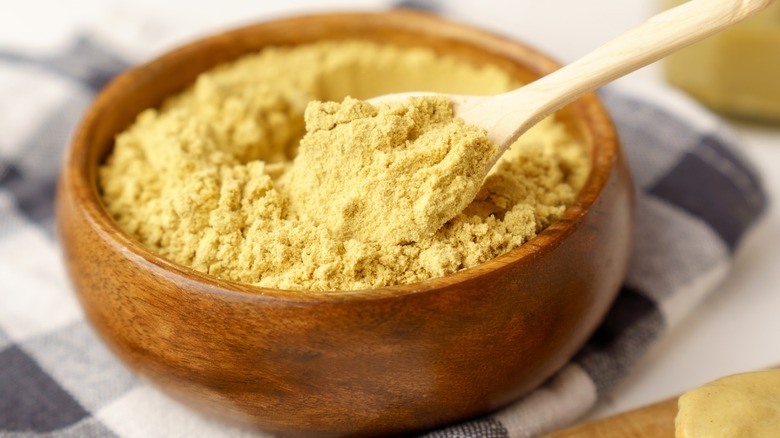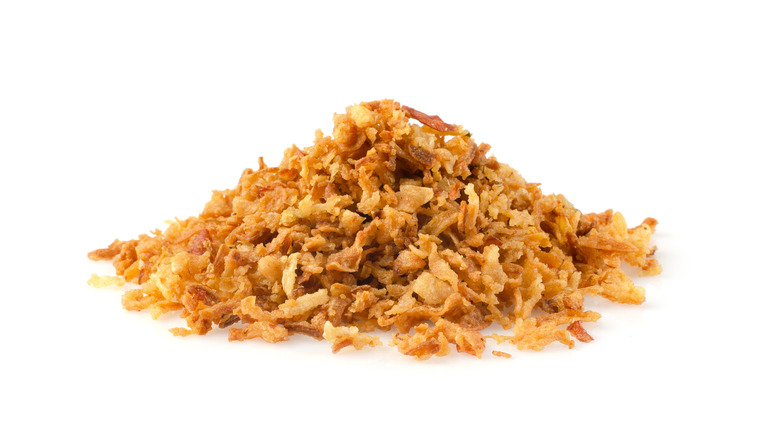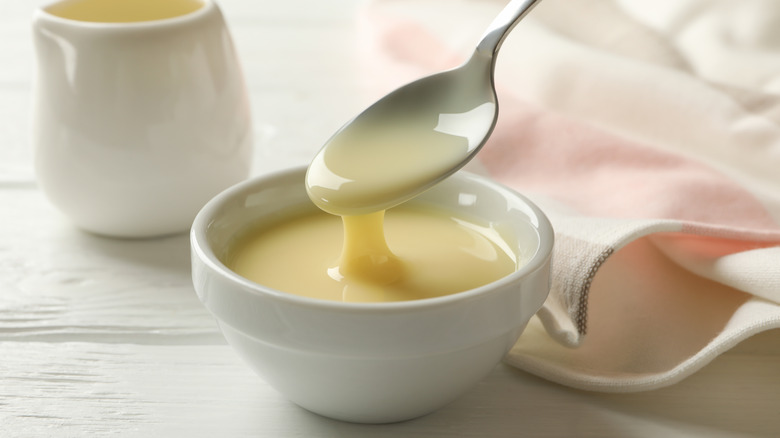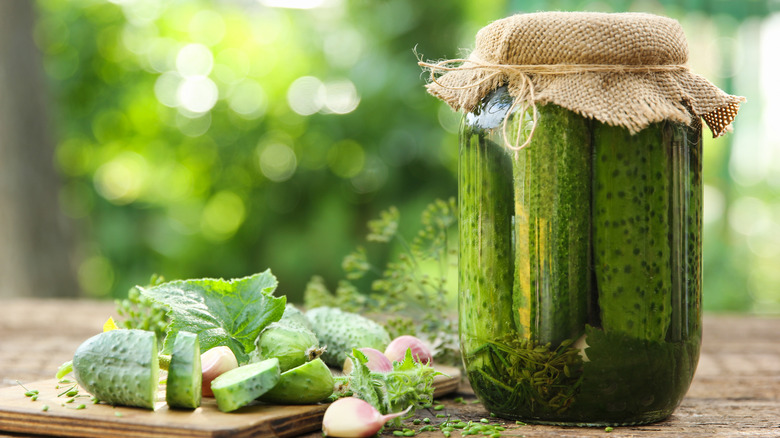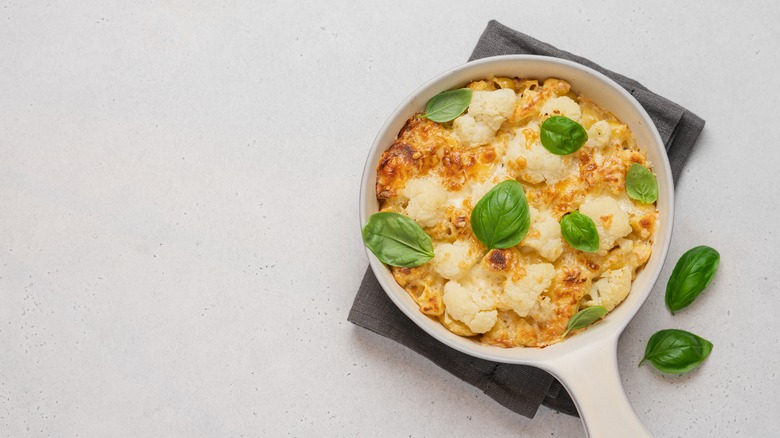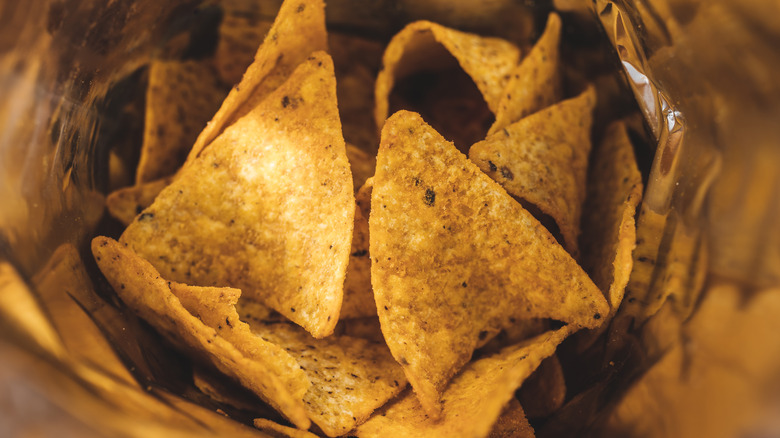15 Unexpected Ingredients To Add To Mac And Cheese
There's really nothing quite like mac and cheese. This comforting staple has been satisfying diners in America for hundreds of years, with Thomas Jefferson's personal chef James Hemings bringing the dish to the United States after his time in Europe. But as it turns out, mac and cheese has an even more extensive history. The dish can be traced back to thirteenth-century Italy in an early form called de lasanis, which combined lasagna sheets and grated cheese. Through the ages, the recipe for mac and cheese developed, and once the processed cheese industry took off in the United States in the 20th century, it morphed into the classic comfort food we know and love today.
A good mac and cheese is a masterclass in simplicity, and in its most basic form, you don't need any more than cheese, pasta, and a few additional ingredients. Now, this is delicious enough — but mac and cheese truly shines as a base for other nifty additions. Like risotto, mac and cheese is seriously adaptable, and by adding in extra ingredients, you can not only bring out the base flavors of the dish but add entirely new notes to it, make it more nutritious, and allow the already-cost-effective meal to stretch even further. And some of the best additions might be pretty surprising.
1. Pumpkin
A good mac and cheese is, first and foremost, creamy. And while certain ingredients work very well to contrast this with sharpness or spice, others work to amp up this creaminess while adding subtle flavor notes to make it slightly more interesting. Pumpkin is one such ingredient. This winter squash becomes seriously soft when cooked into mac and cheese, with just enough bite in each chunk to offer a slight textural contrast. Its nutty flavor pairs very well with the cheese, and it has a sweetness that helps to stop the dish from becoming too one-note.
Adding pumpkin also gives your mac and cheese a boost of nutrition. These fruits are packed with vitamins C and E, as well as beta-carotene, which gives them their orange color, and they're also a good source of fiber. And the good news is that you can add pumpkin in several ways. If you prefer it to be more incorporated, try blending some pumpkin or using pumpkin purée and adding it to your cheese sauce. This will give your mac and cheese a vibrant orange color. If you want a little more body, stir some roasted pumpkin chunks through your mac and cheese before baking it. If you don't have pumpkin, you can sub in any other winter squash, like butternut, acorn, or delicata, and use it in the same way.
2. Truffle butter
Mac and cheese isn't exactly known for being elegant, but there's no reason why you can't make it into a dish a gourmet chef would be proud of. And one easy way to do that is to add truffle butter. This is a favorite trick of celebrity chef Ina Garten, who combines it with two different kinds of mushrooms to give her mac and cheese further body and meatiness while keeping it vegetarian.
Using truffle butter gives your mac and cheese the slightly indefinable yet deeply rich fragrance that truffles provide. The scent of truffles is so moreish thanks to its interesting chemical composition, which is close to the pheromones that mammals release, making it so appealing to humans. Flavor-wise, truffles aren't particularly robust, but they have an uncanny ability to make everything else in food taste even better — so anything else you add to your mac and cheese, like extra mushrooms or additional cheeses, will really pop.
The butter also gives the mac and cheese additional richness and amps up its creamy notes. And while you can use fresh truffles for extra pop, truffle butter is far more affordable and probably easier to find. Bear in mind, too, that although you can also use truffle oil, a lot of them are actually made with synthetic chemicals and not the real stuff.
3. Ground beef
Mac and cheese is a hearty enough dish on its own, but there are occasions that call for it to be bulked out even further. And one of the best ingredients to use is also one that you can find pretty much anywhere. Ground beef can provide extra protein to mac and cheese and give it additional meatiness and depth of flavor. Bear in mind that the type of ground beef you choose will affect the eventual taste, with a higher fat content providing richness while also potentially making your food more greasy. As you already have a fair amount of fat from the cheese, it might be worth going for a leaner ratio, like 85% meat to 15% fat.
You can use ground beef on its own or combine it with additional herbs and spices to make a hamburger mac and cheese. Make sure that you're browning your beef before you stir it into the pasta mixture to ensure that you're getting the richest flavor, and drain off any excess fat or water released. If you're following a plant-based or vegetarian diet, you can also use plant-based imitation ground beef pieces, which are usually made from soy.
4. Peas
For a cost-effective, easy addition, use peas. Peas are one of the best vegetables to add to mac and cheese because of their small, bitesize shape. This allows them to distribute evenly through the mixture and not break up its consistency with large chunks that make it slightly annoying to spoon into your mouth with ease. Taste-wise, they give your mac and cheese a light sweetness and a slight grassiness that offsets the mellow, cheesy flavors. And as most folks have a bag stashed in their freezer somewhere, they're hardly difficult to find.
Peas are also a good way of getting one of your five a day in this otherwise-rich dish. These tiny vegetables are exceptionally high in vitamin C and fiber, and two pigments in them, called lutein and zeaxanthin, are especially beneficial to your eye health, according to WebMD. As frozen peas defrost so quickly, too, you can pour them straight into your mac and cheese just before you serve or bake it, giving it a stir to ensure they're fully thawed. You can also stir in defrosted peas, but if you're going to then bake your mac and cheese for a significant amount of time, they may become overly soft and lose their greenness.
5. Tater tots
If your mac and cheese needs to stretch a little further, you can't do much better than tater tots. These easy-to-find additions pair perfectly with the richer flavors of the cheese without distracting from the main notes of the dish too much, and they also give an added saltiness. When cooked, they become crispy on the outside and pillowy inside, giving the meal an extra textural interest. And you can find two-pound bags of tater tots in most stores for just a few dollars, so this one won't break the bank.
There are loads of ways to use tater tots in your mac and cheese. If you want to give your dish a bit more body, try stirring them through before you bake, leaving little nuggets poking out the top to brown. Or, for a next-level topping, sub out your breadcrumbs for tater tots, and layer some over the top of the casserole dish before you put it in the oven. When you pull it out, the tater tots will be crispy and golden brown. For something really special, toss some frozen tater tots in your waffle iron until crispy, and then spoon your mac and cheese over them to make a loaded tater-tot dish of dreams.
6. Chipotle
Mac and cheese is one of those dishes that does a few flavors really well. But while creaminess, saltiness, and umami are front and center, it can also sometimes get a little one-note. That's where chipotle comes in. Adding chipotle to mac and cheese gives it layers of smokiness and heat, giving the meal a two-tone flavor that stops it from becoming boring or a chore to eat. Grab some jarred chipotle paste and stir it through the pasta and cheese, or use a few dashes of dried, ground chipotle for a more intense spice.
It's worth remembering that chipotle isn't its own strand of chili pepper but rather is a jalapeño pepper that's been dried and smoked. As such, it has a much more mellow flavor than young jalapeños, which can be way sharper and brinier, especially when they've been jarred. chipotle also has a sweetness to it, which further adds to its complexity.
The pepper is smokey enough on its own, but if you really want to bring out those flavors, try stirring a little bit of smoked cheese into your regular cheese mix. Just be wary about how much chipotle you add. A little can go a long way, and while the dairy in the mac and cheese will temper it somewhat, it'll be difficult to reduce the intensity once the dish is already cooked.
7. Manchego
Mac and cheese can technically be made with any cheese you like, but typically, cheddar, Velveeta, and Gruyere are the most commonly used. These cheeses can sometimes lack punch, though, and for something more punchy, consider using Manchego, a Spanish sheep's milk cheese that has a salty, sharp kick.
Manchego is usually a pale white with a crumbly texture and an easy ability to melt, helping it incorporate into your mac and cheese well. Flavor-wise, it has an interesting balance of butteriness and sourness, and its aging in a salt brine also amps up its salt content. The cheese pairs very well with other typically Spanish flavors, like in this Manchego mac and cheese with fresh chorizo.
It's useful to keep in mind, though, that Manchego can be on the more expensive side, especially if you're getting it from a specialist food store. Additionally, using Manchego solely in your mac and cheese could potentially overpower the dish, as it's a cheese that's best enjoyed in smaller doses due to its intense flavor. We recommend pairing it with a cheese more frequently used in this dish, like cheddar or Velveeta.
8. Spinach
If you want some vegetables with your mac and cheese but don't want to cook them separately, spinach is the answer. Spinach offers an excellent contrast to the flavors in mac and cheese, bringing freshness and vibrancy while also pairing effortlessly with the richness of the dairy. Spinach is also one of the most nutritious leafy greens out there and is especially abundant in minerals like calcium, magnesium, potassium, and iron. These minerals play an important part in maintaining our regular bodily function, with magnesium, in particular, keeping our nervous and cardiovascular systems running smoothly, according to Medical News Today.
Anyone who's ever cooked spinach will know how quickly it reduces in size, so there's no need to chop it up before putting it in mac and cheese unless your leaves are especially large. You will, however, need to wilt it first. Wilting the spinach makes it easier to work with and also stops it from releasing extra water into your cheese sauce and diluting the dish. You can do this quickly by steaming it or just by adding it to a pan with a little butter, allowing it to steam via its own natural moisture. If you have baby spinach, you can also use it to top the casserole dish, creating a crispy lid, as in this Tuscan mac and cheese.
9. Sun-dried tomatoes
Preserved foodstuffs are a superb way to add high amounts of flavor with very little effort. And with mac and cheese, sun-dried tomatoes are a natural pairing. These tomatoes develop a seriously rich, intense umami flavor through their drying process. And all of that concentrated goodness gives the mac and cheese a base flavor that's subtle but endlessly enriching.
To add sun-dried tomatoes, chop them up into bite-sized pieces, and stir them through the mac and cheese thoroughly before baking. The tomatoes will retain their chewiness, which also makes the dish a bit more interesting to eat. Sun-dried tomatoes generally come packed and marinated in oil, and pouring a little into the mac and cheese will give it further flavor, don't add too much, though, or you risk making it too fatty.
And if you fancy making some yourself, you don't actually need the sun to make your own sun-dried tomatoes. Place some halved tomatoes in a low-temperature oven for approximately 6-8 hours, checking them periodically to make sure they're not burning. Once they've dried out, pop them in a jar with some oil infused with garlic and herbs for a day or two, and then use them at your leisure.
10. Mustard
Mustard can give any meal a brininess and satisfying pungency, as well as a heat that hits differently from the classic fire of chili. And it works incredibly well in mac and cheese. Mustard and cheese have slightly similar flavor profiles, meaning that mustard doesn't distract in the same way that a different spicy element might, but the punch of the condiment stops the dairy from becoming too flat.
And while you can certainly add regular mustard to mac and cheese, The Pioneer Woman blog writer Ree Drummond uses powdered instead. Drummond adds a few teaspoons to her mac and cheese, stirring it into her cheese sauce before it's combined with the pasta. It's useful to note that dry mustard is different from prepared mustard and is made by crushing up the mustard seeds that serve as the base of the condiment.
Prepared mustard has further ingredients added to it, usually, acidic elements that make it much sharper. Because of this, dry mustard has an altogether more subtle flavor and may be less boisterous that adding Dijon or even classic yellow mustard. It may also be better for folks who find the heat of stronger mustard sauces too intense and nose-tickling.
11. Crispy fried onions
A breadcrumb coating or a layering of crispy baked cheese gives mac and cheese a crunch factor that's otherwise lacking through the sometimes-stodgy meal and just makes the whole thing taste a bit lighter. And you should also try using canned fried onions. These crispy morsels of onion are coated and deep-fried before being packaged and are full of deep, toasty, umami flavor, which is supplied with no additional work.
Store-bought crispy fried onions are usually pretty easy to find and have a long shelf life. And these onions are awesome for hacking your mac and cheese, so you don't have to bake it. Just sprinkle them over the top of stovetop mac and cheese, and you have an oven-worthy crunchy topping without having to cook. You can also bake it as normal, but keep an eye on your dish to ensure the onions don't burn, as they'll become acrid and bitter if they do.
12. Evaporated milk
While mac and cheese recipes can vary, a large proportion of them are made by combining cooked pasta with a béchamel or cheese sauce and then baking the mixture or serving straight away. These sauces, made by combining milk with butter, flour, and cheese, are crucial for the dish's thickness. But there's a nifty way to skip making the sauce separately by using evaporated milk.
This ingredient is used by Alton Brown in his stovetop mac and cheese. Brown simmers the pasta in a small amount of water until it's cooked and then adds to it a combination of evaporated milk, whole eggs, mustard, and Aleppo pepper, as well as butter and some handfuls of spinach. Once everything's combined, he then stirs in grated cheese, and when it's melted, it's ready to serve.
The evaporated milk and eggs work as the béchamel sauce, giving the dish body by creating a cream-like consistency. It should be remembered that evaporated milk isn't the same as condensed milk, although the two are both made in similar ways by cooking milk until its water content has reduced significantly. The difference is that condensed milk is sweetened, whereas evaporated milk is not. Just make sure you don't mix up the two, as you could end up with mac and cheese that's way too sugary.
13. Pickles
Pickles and cheese work awesomely together. From the combination of the two on a cheeseburger to a simple slice of each balanced on a cracker, they both have qualities that the other foodstuff lacks. Pickles, for their part, deliver a tartness and funkiness, which is created through the fermentation process as the sugars in the vegetable turn to acid, giving them their sour notes. This works to offset the dairy content in cheese well and highlights its own sharp flavors.
That's why pickles work so well in mac and cheese. While they are slightly unusual, they're a great way to cut through the combination of rich dairy and starchiness from the pasta. Dice up your pickles so they're super-small, so they can distribute through the pasta mixture evenly, and stir them straight into the cheese sauce. We'd recommend using less than you think to start so that you don't overpower the meal with sourness. If you think it needs a little more punch, try pouring in a little of the pickle brine.
Pickles don't just add flavor, either. As a fermented food, they have a probiotic benefit, promoting a healthy balance of gut bacteria and improving digestion, as stated by the Cleveland Clinic. Remember, however, that pickles can be on the salty side, and cheese can too — so try and find low-sodium pickles if you can.
14. Cauliflower
If you haven't tried cauliflower in mac and cheese yet, you're missing out. While it might sound strange, cauliflower is uniquely well-suited to being paired with cheese, as anyone who's tried the traditional British side dish cauliflower cheese can attest to. When cooked, cauliflower has a softness and a relatively neutral flavor that provides a perfect vehicle for sharper, more heavily-flavored cheese sauces — and it also makes your meal go even further while keeping costs down.
You can make a simple Instant Pot cauliflower mac and cheese by cooking the vegetable and the noodles together before combining it with the sauce and serving. For a classic baked mac and cheese, cook your cauliflower before breaking it into bitesize florets and stirring it through. If you're boiling or steaming your cauliflower, its flavor will remain more subtle. Roasting your cauliflower, however, is a great way to bring out the deeper, more complex tastes of the vegetable, with the caramelization of the surface giving way to nuttier flavors. If you wish, you can even skip the pasta entirely and just use cauliflower by making a gluten-free cauliflower mac and cheese.
15. Doritos
Breadcrumbs give a crunch to mac and cheese, but they can also be pretty boring. Unless you're using seasoned breadcrumbs, sprinkling them on top of your dish can inadvertently sap it of flavor, diluting the sharp mac and cheese with blandness. But the solution might be in your snack drawer.
Crumbling Doritos over the pasta and cheese is a quick way to give it a boost of intense flavor. You can crush them to whatever size you like and use a combination of flavors. One of the best things about using Doritos is how many options you have to choose from, and you can pick the one that works best for your mac and cheese. For a classic dish, go for the White Cheddar flavor, which will combine seamlessly with the flavors of your sauce. Cool Ranch Doritos also work excellently, whereas the spicier flavors like Flamin' Hot Nacho or Flamas can bring heat to the table.
Crucially, while Doritos can be heated in the oven, they're not immune to burning. If you're baking them on top of mac and cheese, try to limit the cooking time to around 10 minutes or sprinkle them on towards the end. As Doritos are already crunchy, though, you might wish to just crush them over a stovetop mac.
